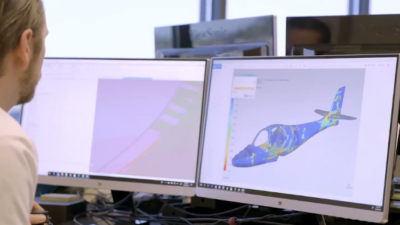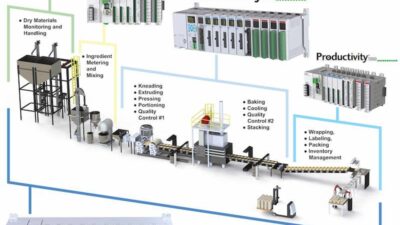Remember that last automation project? Remember the extended startup because of automation system software errors? The operator mistakes that caused reworked projects? The unscheduled shutdown from untested process interlocks? That near recordable emissions release? Remember the operations manager asking, “Isn’t there a better way to test our automation system and train operators b...
Remember that last automation project? Remember the extended startup because of automation system software errors? The operator mistakes that caused reworked projects? The unscheduled shutdown from untested process interlocks? That near recordable emissions release? Remember the operations manager asking, “Isn’t there a better way to test our automation system and train operators before we try to start up?” Process manufacturers like Lily, BP, Merck, Monsanto, Solutia, Shell, and BASF know that the answer to the operations manager’s question is to use simulation systems based on industrial Ethernet as a communications infrastructure.
According to Dr. Tom Fiske in his report, “Using Simulation to Optimize Results of Automation Projects,” the use of simulation for automation projects and automation lifecycle management provides numerous benefits achieved by using simulation to checkout and validate process automation systems, perform software acceptance tests, and train operators.
In general, says Fisk, a simulator platform for process automation testing connects to the control system via communication interfaces. The simulator accepts all the control system outputs and returns the appropriate response as if it were the real process. In this way, testing of the process automation system occurs in a safe environment without disrupting manufacturing operations. Although the fidelity of simulator used for process automation testing is relatively low, its value is relatively high.
Operator training simulators, on the other hand, enable operators to learn the functionality of the process automation system without the pressure of controlling the actual plant. The fidelity of training simulators is relatively high compared to simulations used for testing process automation systems.
Fisk mentions Mimic Simulation Software from Mynah Technologies as a product that “meets or exceeds all the requirements for a simulation system” for either function. Mynah contends that its use of industrial Ethernet as an enabling technology allows quicker system setup, better simulation system performance, and more flexible testing and training systems.
Long setup times eliminated
Legacy simulation systems use serial or proprietary communications for simulation system infrastructure, says Mynah’s director of technology, Nobin William. Although this was a good solution at one time, he says these systems have limitations, including long setup times (as much as four hours), extensive PC I/O and interrupt configuration, the need for proprietary PC ISA cards, and limited system flexibility.
As a communications gateway for simulation of Emerson DeltaV Process Systems, however, the Mynah Virtual I/O Module (VIM) addresses these limitations with a 15-minute setup, the use of standard CAT5 cables, and simulation messaging using COTS Ethernet switches and networks. Communications speed and throughput are improved, says William, with simulation system Foundation Fieldbus device commissioning time reduced from 30 seconds to almost instantaneous. Simulated IO update times are in the millisecond range even with heavily-loaded systems, he adds.
Using offline simulation systems based on Industrial Ethernet adds the benefits of faster time to market, improved product quality, reduced operating cost, and mitigated risks.
The BASF plant near Hannibal, MO, uses Mynah’s VIM and Mimic simulation with DeltaV in its production of agricultural chemicals. Dr. John Lewis at BASF noted the obvious improvements in plant efficiency by using the VIM: “We have used Mimic simulation software for several years now and transitioned from the early hard-wired WATS cards to the new VIMs using industrial Ethernet. The change has undeniably been a vast improvement.
“We were able to remove an old and bulky piece of hardware and replace it with smaller more capable modules. The freedom to place hardware anywhere, as long as it was connected to the network, allowed us to more efficiently use space and access the system from locations where it was previously not possible. Training and demonstrations were free to take place anywhere we were able to connect to the network.”
This integrated Mimic system at BASF has evolved from needing a knowledgeable and skilled technician to install to a system that is as close to plug and play as anything else in the computer world, says Lewis. “Industrial Ethernet has cut our maintenance needs and improved our reliability.” He says he looks forward to using industrial Ethernet applications in the future.
Industrial Ethernet is being used by Mynah as the simulation infrastructure for automation platforms other than DeltaV. “We are very happy with our experience with using industrial Ethernet for our Mimic Simulation Software drivers,” said Mynah’s William. “In addition to the Virtual IO Module, we have industrial Ethernet simulation drivers that use OPC, Modbus TCP/IP, COM, and Ethernet/IP.”
Mynah recently released a new product, the Mimic Simulation Driver for Open Modbus TCP/IP. This high-speed driver allows non-intrusive simulation for controllers that support Modbus TCP/IP protocols such as Schneider Quantum PLCs and HIMA SIS PLCs.
Author Information
Renee Robbins is senior editor for Control Engineering. She can be reached at [email protected] .
PoE products pre-empt standard
The standard for a higher power version of Power over Ethernet (PoE), IEEE 802.3 at, is at least a year away from being ratified by the IEEE. This standard would allow for PoE-enabled operation of devices requiring more than the 12.95 W permitted by the existing standard. Vendors of PoE-enabling technologies and equipment are not waiting, however. A number of vendors have released products conforming to the higher power specifications. Read this article online under


